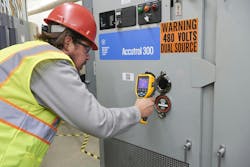How Power Quality Analysis Can Lead to Improved Energy Efficiency
Optimizing energy efficiency in today’s industrial and commercial landscapes is more crucial than ever. One often overlooked yet vital aspect of achieving this optimization is power quality analysis, which ensures that the electricity supplied to a facility meets the required standards for equipment operation.
What is power quality analysis?
Power quality analysis involves evaluating the electricity being provided to a facility and the loads connected to its electrical panels. This process is fundamental because equipment such as computers, motors, and pumps all have specific power requirements to operate efficiently. If the quality of power deviates from these requirements, the equipment may not function optimally, leading to inefficiencies and increased operational costs.
The impact of poor power quality on energy efficiency
Power quality issues directly affect the energy efficiency of a facility. Every electrical device consumes power. By using a power quality analyzer, one can break down the cost of power consumption into specific components. These components reveal stories about the quality of power and how it impacts energy efficiency.
Common PQ issues affecting energy efficiency
- Resistive losses: Electrical wiring and connections inherently possess resistance, which results in power losses. Though changing electrical wiring can be challenging, tools like thermal imagers can help identify loose connections. Fixing these connections can significantly reduce resistive losses, thereby improving overall energy efficiency.
- Harmonics: Harmonics are distorted frequencies generated by electronic loads that disrupt the normal operation of electrical systems. These frequencies create additional heat rather than performing useful work, which can reduce the efficiency of motors and other equipment. Using a power analyzer to identify the harmonic components and their magnitudes, facilities can implement appropriate mitigation strategies to reduce harmonic distortion and lower energy costs.
- Electrical unbalance: Electrical unbalance occurs when the load is not evenly distributed across phases, leading to increased energy consumption and negative impacts on motors. Addressing and reducing electrical unbalance can lead to significant energy savings and improved performance.
- Power factor: Power factor is a measure of how efficiently power is delivered and used. A poor power factor can result in additional utility charges and may necessitate upgrading electrical panels to support extra loads. By improving the power factor, facilities can reduce these extra charges and potentially avoid costly panel upgrades.
Understanding and mitigating harmonic distortion
Harmonic distortion arises when non-linear loads or electronic devices introduce frequencies that are multiples of the fundamental power frequency. These harmonic frequencies generate heat instead of performing useful work and can interfere with motor operations.
To tackle harmonic distortion, electrical professionals can use advanced power quality analyzers. These analyzers align measurements with power quality standards such as IEEE 519, Standard for Harmonic Control in Electric Power Systems, and provide pass/fail analysis of harmonic components. Total harmonic distortion (THD) is a key metric to determine if further analysis is required. Once harmonics are identified, there are two primary mitigation methods:
- Passive mitigation: This involves using filters to block specific harmonic frequencies. These filters target and eliminate the identified harmonics, thus reducing their impact on the system.
- Active mitigation: Active mitigation techniques counteract harmonics in real time. These methods dynamically address harmonic frequencies as they occur, improving the overall power quality and efficiency of the system.
Conclusion
Power quality analysis is a powerful tool for enhancing energy efficiency and reducing operational costs in industrial and commercial facilities. By identifying and addressing issues such as resistive losses, harmonics, electrical unbalance, and power factor, electrical professionals can help facilities achieve significant improvements in energy efficiency. Implementing proper mitigation strategies for these power quality issues not only reduces energy consumption but also extends the lifespan of equipment and minimizes additional costs.
About the Author

Jason Axelson
Jason is a subject matter expert at Fluke specializing in power quality, electrical test equipment, and product applications. With deep experience supporting both customers and distribution partners, he helps professionals select, operate, and troubleshoot a wide range of diagnostic tools, including power quality analyzers, battery testers, acoustic imagers, and thermal imagers. Jason regularly leads application-based training sessions, drawing on his hands-on knowledge to bridge the gap between technical challenges and practical solutions across industries.


